struts2里面的各个功能,现在确实都不清楚,完全属于新学!
通过前面的例子,有时就会疑问,这些jsp中的数据信息是怎么传送给action的?例如:
1 <form action = "LoginAction.action" method="post"> 2 <p>用户名 <input type = "text" name="user.name"/></p> 3 <p>密码 <input type = "text" name="user.password"/></p> 4 <input type = "submit" value = "登录"/> 5 </form>
user.name是怎么传给action的? action是怎么获取的??这个就是下面讲解的struts2参数自动封装!
一:struts2参数自动封装
前篇文章对struts2的一个入门,重点是对struts2的架构图有一个大概的了解即可,之后的几篇文章,就是细化struts2,将struts2中的各种功能进行梳理,其实学完之后,对struts2的使用不外乎这几点,参数自动封装,拦截器的使用,数据校验,ognl表达(值栈和actionContext的讲解),struts2的标签,struts2的国际化,struts2的文件上传下载。 把这几个功能都学会了使用之后,struts2基本上就学完了。所以接下来的文章就是对这几个功能进行讲解。如何使用。而进行就对数据自动封装和数据类型自动转型进行讲解。
什么叫封装呢?其实就是把用户输入的数据获取到,然后输出或者封装到类里面去。

1.1 静态参数封装
action获取struts.xml中的参数--------是从struts.xml中获取。
——静态参数,也就是我们写死的数据,不能算是用户动态提交的数据。下面给一个例子:
1 <?xml version="1.0" encoding="UTF-8" ?> 2 <!DOCTYPE struts PUBLIC 3 "-//Apache Software Foundation//DTD Struts Configuration 2.3//EN" 4 "http://struts.apache.org/dtds/struts-2.3.dtd"> 5 6 <struts> 7 8 <constant name="struts.enable.DynamicMethodInvocation" value="false" /> 9 <constant name="struts.devMode" value="true" /> 10 11 <package name="zxl" namespace="/" extends="struts-default"> 12 13 <action name="MyParaAction" class="action.MyParaAction" method="test01"> 14 <result name="success">/index.jsp</result> 15 <param name="username">zhangsan</param> 16 <param name="password">12345</param> 17 </action> 18 19 <action name="MyParaAction2" class="action.MyParaAction2" method="test01"> 20 <result name="success">/index.jsp</result> 21 <param name="user.username">zhaosi</param> 22 <param name="user.password">12345</param> 23 </action> 24 25 </package> 26 </struts>
我们来看第一个action:MyParaAction.java
1 package action; 2 3 import com.opensymphony.xwork2.ActionSupport; 4 5 public class MyParaAction extends ActionSupport { 6 7 private String username; 8 private String password; 9 /** 10 * @return the username 11 */ 12 public String getUsername() { 13 return username; 14 } 15 /** 16 * @param username the username to set 17 */ 18 public void setUsername(String username) { 19 this.username = username; 20 } 21 /** 22 * @return the password 23 */ 24 public String getPassword() { 25 return password; 26 } 27 /** 28 * @param password the password to set 29 */ 30 public void setPassword(String password) { 31 this.password = password; 32 } 33 34 public String test01(){ 35 36 System.out.println("username : " + username + ", password : " + password); 37 38 return "success"; 39 } 40 41 }
加入本测试不关注的index.jsp
1 <%@ page language="java" contentType="text/html; charset=ISO-8859-1" 2 pageEncoding="ISO-8859-1"%> 3 <!DOCTYPE html PUBLIC "-//W3C//DTD HTML 4.01 Transitional//EN" "http://www.w3.org/TR/html4/loose.dtd"> 4 <html> 5 <head> 6 <meta http-equiv="Content-Type" content="text/html; charset=ISO-8859-1"> 7 <title>Insert title here</title> 8 </head> 9 <body> 10 Hi, Struts2!!! 11 12 </body> 13 </html>
我们在浏览器输入:http://localhost:8080/Struts2Demo/MyParaAction
可以看到浏览器输出:Hi, Struts2!!!
而我们看控制台:username : zhangsan, password : 12345
可以看到在struts.xml中配置的参数传递到了action。
上面这种静态参数是直接定义在action里面,没有对应的实体内。下面我们看有实体内的静态参数怎么传给action:
MyParaAction2的action已经在前面struts.xml已经配置了。看具体action和JavaBean实体类:
1 package login; 2 3 public class User { 4 5 private String username; 6 private String password; 7 8 /** 9 * @return the username 10 */ 11 public String getUsername() { 12 return username; 13 } 14 15 /** 16 * @param username the username to set 17 */ 18 public void setUsername(String username) { 19 this.username = username; 20 } 21 /** 22 * @return the password 23 */ 24 public String getPassword() { 25 return password; 26 } 27 /** 28 * @param password the password to set 29 */ 30 public void setPassword(String password) { 31 this.password = password; 32 } 33 34 }
1 package action; 2 3 import com.opensymphony.xwork2.ActionSupport; 4 5 import login.User; 6 7 public class MyParaAction2 extends ActionSupport { 8 9 private User user; 10 11 /** 12 * @return the user 13 */ 14 public User getUser() { 15 return user; 16 } 17 18 /** 19 * @param user the user to set 20 */ 21 public void setUser(User user) { 22 this.user = user; 23 } 24 25 26 public String test01(){ 27 28 System.out.println("user info:"+ user.getUsername() +" " + user.getPassword()); 29 return "success"; 30 } 31 32 33 }
在浏览器输入:http://localhost:8080/Struts2Demo/MyParaAction2
同样浏览器输出:Hi, Struts2!!!
控制台输出:user info:zhaosi 12345
从上面可以看出,主要是根据action中定义的情况来配置struts.xml。至于传进去的参数怎么返回给jsp等,不是这个讨论的,后面继续。
——因为在我们执行test01()方法的前后,有很多拦截器interceptor做一些工作,其中有一个叫做staticParams的拦截器,它就是专门负责看看你struts.xml里的action里是否有定义param参数,如果有的话,拿到这个参数的name名字,然后去这个action的对应的类class里面的方法method去找setXXX方法,和setXXX中set后面的XXX比较(这里它会自动转换大小写),如果发现有匹配的,就把值复制给类class里面的变量。然后我们在执行这个方法method的时候,这个变量其实就已经有值了,我们输出到控制台的时候就能看到值了。
记住:静态参数封装就是从struts.xml中获取数据传给action.
1.2 动态参数封装
动态参数封装。核心的例子就是表单数据的提交。所以这个地方开始肯定有表单jsp

1.2.1 属性驱动
1.2.1.1 基本属性驱动: 基本属性驱动就是数据模型和动作类写在一起(即动作类中有数据模型)
我们看下面这个例子,同样以上面action为例:
1 package action; 2 3 import com.opensymphony.xwork2.ActionSupport; 4 5 public class MyParaAction extends ActionSupport { 6 7 private String username; 8 private String password; 9 /** 10 * @return the username 11 */ 12 public String getUsername() { 13 return username; 14 } 15 /** 16 * @param username the username to set 17 */ 18 public void setUsername(String username) { 19 this.username = username; 20 } 21 /** 22 * @return the password 23 */ 24 public String getPassword() { 25 return password; 26 } 27 /** 28 * @param password the password to set 29 */ 30 public void setPassword(String password) { 31 this.password = password; 32 } 33 34 public String test01(){ 35 36 System.out.println("username : " + username + ", password : " + password); 37 38 return "success"; 39 } 40 41 }
添加表单页面:login1.jsp
1 <%@ page language="java" contentType="text/html; charset=UTF-8" 2 pageEncoding="UTF-8"%> 3 <!DOCTYPE html PUBLIC "-//W3C//DTD HTML 4.01 Transitional//EN" "http://www.w3.org/TR/html4/loose.dtd"> 4 <html> 5 <head> 6 <meta http-equiv="Content-Type" content="text/html; charset=UTF-8"> 7 <title>登录实例</title> 8 </head> 9 <body> 10 <form action = "MyParaAction" method="post"> 11 <p>用户名 <input type = "text" name="username"/></p> 12 <p>密码 <input type = "text" name="password"/></p> 13 <input type = "submit" value = "登录"/> 14 </form> 15 </body> 16 </html>
在浏览器输入:http://localhost:8080/Struts2Demo/login1.jsp, 浏览器输出:
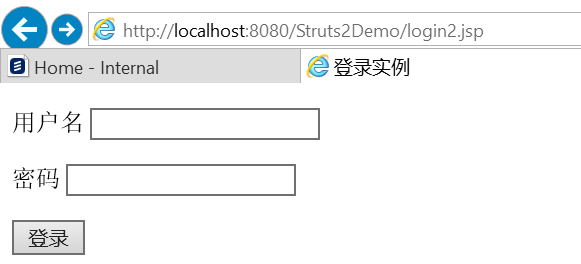
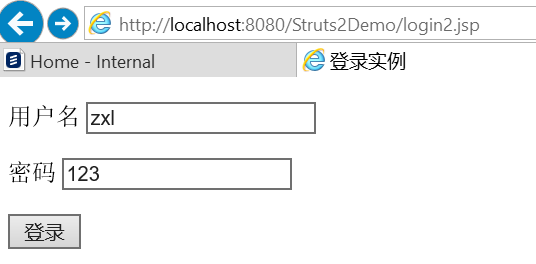
在输入框输入用户名和密码,然后看到控制台输出:username : zxl, password : 123
这个地方注意了,我没有修改struts.xml,也就是说里面action还是配置了静态参数的。但结果是动态参数会直接覆盖静态参数的传递。
此方式简单易懂,但是在实际开发中,用的不是很多,局限性大,并且数据模型和动作类写在一个类中,不利于解耦管理。由此出现了动态参数封装的第二种方式。
1.2.1.2 ognl表达式来封装数据: 数据模型和动作类分别写在不同类中(即数据模型建立javabean)
就按照前面第二个action,即:MyParaAction2.java, 里面User 和Action不在同一个class中。
1 package action; 2 3 import com.opensymphony.xwork2.ActionSupport; 4 5 import login.User; 6 7 public class MyParaAction2 extends ActionSupport { 8 //动作类中只有一个javabean对象。通过set.get方法进行管理 9 private User user; 10 11 /** 12 * @return the user 13 */ 14 public User getUser() { 15 return user; 16 } 17 18 /** 19 * @param user the user to set 20 */ 21 public void setUser(User user) { 22 this.user = user; 23 } 24 25 26 public String test01(){ 27 28 System.out.println("user info:"+ user.getUsername() +" " + user.getPassword()); 29 return "success"; 30 } 31 } 32 33 //所需要的数据模型: 34 package login; 35 36 public class User { 37 38 private String username; 39 private String password; 40 41 /** 42 * @return the username 43 */ 44 public String getUsername() { 45 return username; 46 } 47 48 /** 49 * @param username the username to set 50 */ 51 public void setUsername(String username) { 52 this.username = username; 53 } 54 /** 55 * @return the password 56 */ 57 public String getPassword() { 58 return password; 59 } 60 /** 61 * @param password the password to set 62 */ 63 public void setPassword(String password) { 64 this.password = password; 65 } 66 67 }
然后看我们的表单页面:login2.jsp
1 <%@ page language="java" contentType="text/html; charset=UTF-8" 2 pageEncoding="UTF-8"%> 3 <!DOCTYPE html PUBLIC "-//W3C//DTD HTML 4.01 Transitional//EN" "http://www.w3.org/TR/html4/loose.dtd"> 4 <html> 5 <head> 6 <meta http-equiv="Content-Type" content="text/html; charset=UTF-8"> 7 <title>登录实例</title> 8 </head> 9 <body> 10 <form action = "MyParaAction2" method="post"> 11 <p>用户名 <input type = "text" name="user.username"/></p> 12 <p>密码 <input type = "text" name="user.password"/></p> 13 <input type = "submit" value = "登录"/> 14 </form> 15 </body> 16 </html>
同样在浏览器输入:http://localhost:8080/Struts2Demo/login2.jsp 在输入框输入信息:
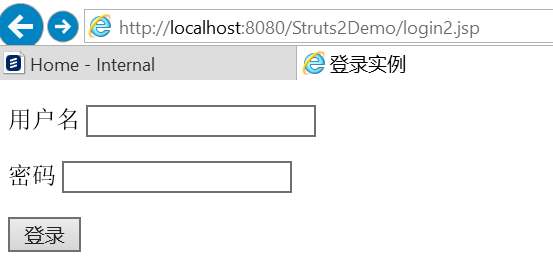
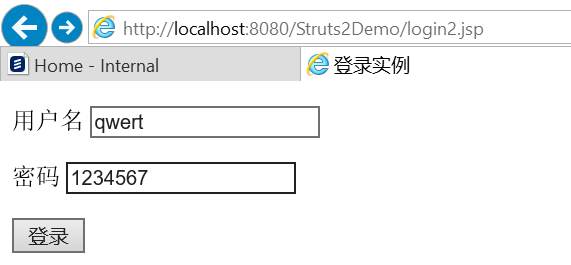
控制台输出:user info:qwert 1234567。
同样可以看出,也没有修改struts.xml 里面同样还是配置了静态参数, 但是动态参数依然会覆盖掉静态参数。
表单中的name属性值必须是javabean的对象的属性,不是简单的username了,变成了user.username。
还有动作类中set.get方法的执行顺序:
get方法:struts2先调用get方法,判断对象是否存在,如果不存在,使用反射创建一个对象。
set方法:不存在的时候,创建一个对象,把它set进去
get方法:再调用get方法得到对象,调用set方法得到对象的各种属性,为属性赋值。
在jsp页面中的user.name和user.age其实就是ognl表达式,代表着往根(root,值栈valueStack)中存放值,而值栈中的栈顶元素也就是为当前action,我们在action中设置user的get、set属性,即可以让存进来的值匹配到,进而将对应属性赋值成功。
上面这种参数封装属于OGNL中的封装对象。
下面看一下封装列表和map
下面先看OGNL封装List 例子:
1 package action; 2 3 import java.util.List; 4 5 import com.opensymphony.xwork2.ActionSupport; 6 7 import login.User; 8 9 public class MyParaAction2 extends ActionSupport { 10 11 //创建用户对象,在JSP中用OGNL封装对象来获取参数 12 private User user; 13 //创建List对象,在JSP中用OGNL封装列表list来获取参数 14 private List<User> users; 15 16 /** 17 * @return the user 18 */ 19 public User getUser() { 20 return user; 21 } 22 23 /** 24 * @param user the user to set 25 */ 26 public void setUser(User user) { 27 this.user = user; 28 } 29 30 /** 31 * @return the users 32 */ 33 public List<User> getUsers() { 34 return users; 35 } 36 37 /** 38 * @param users the users to set 39 */ 40 public void setUsers(List<User> users) { 41 this.users = users; 42 } 43 44 public String test01(){ 45 46 System.out.println("user info:"+ user.getUsername() +" " + user.getPassword()); 47 return "success"; 48 } 49 50 public String test03(){ 51 System.out.println("test03"); 52 System.out.println("user1 info:"+ users.get(0).getUsername() +" " + users.get(0).getPassword()); 53 System.out.println("user2 info:"+ users.get(1).getUsername() +" " + users.get(1).getPassword()); 54 return "success"; 55 } 56 57 public String test04(){ 58 System.out.println("test04"); 59 System.out.println("user1 info:"+ users.get(0).getUsername() +" " + users.get(0).getPassword()); 60 System.out.println("user2 info:"+ users.get(1).getUsername() +" " + users.get(1).getPassword()); 61 return "success"; 62 } 63 }
然后我们来看一下表单页面:login3.jsp
1 <%@ page language="java" contentType="text/html; charset=UTF-8" 2 pageEncoding="UTF-8"%> 3 <!DOCTYPE html PUBLIC "-//W3C//DTD HTML 4.01 Transitional//EN" "http://www.w3.org/TR/html4/loose.dtd"> 4 <html> 5 <head> 6 <meta http-equiv="Content-Type" content="text/html; charset=UTF-8"> 7 <title>登录实例</title> 8 </head> 9 <body> 10 <form action = "Login3!test03" method="post"> 11 <p>用户名1 <input type = "text" name="users[0].username"/></p> 12 <p>密码 <input type = "text" name="users[0].password"/></p> 13 <p>用户名2 <input type = "text" name="users[1].username"/></p> 14 <p>密码 <input type = "text" name="users[1].password"/></p> 15 <input type = "submit" value = "登录"/> 16 </form> 17 </body> 18 </html>
这个表单页面是不是和前面有点不一样了:
首先,后面传递的参数users[0].username,users[0].password,users[1].username,users[1].password就是用OGNL对List进行的封装。
这个地方的list必须与动作类中定义的list完全对应。
其次action处是:Login3!test03,看到这个要想到这个是动态函数调用。和struts.xml配合使用。
我们看一下struts.xml
<?xml version="1.0" encoding="UTF-8" ?> <!DOCTYPE struts PUBLIC "-//Apache Software Foundation//DTD Struts Configuration 2.3//EN" "http://struts.apache.org/dtds/struts-2.3.dtd"> <struts> <constant name="struts.enable.DynamicMethodInvocation" value="true" /> <constant name="struts.devMode" value="false" /> <package name="zxl" namespace="/" extends="struts-default"> <action name="MyParaAction" class="action.MyParaAction" method="test01"> <result name="success">/index.jsp</result> <param name="username">zhangsan</param> <param name="password">12345</param> </action> <action name="Login3" class="action.MyParaAction2" > <result name="success">/index.jsp</result> </action> <action name="Login4_*" class="action.MyParaAction2" method="{1}"> <result name="success">/index.jsp</result> </action> </package> <include file="example.xml"/> <include file="struts-constant.xml"/> <include file="struts-dynamic.xml"/> <include file="struts-actionsupport.xml"/> <!-- Add packages here --> </struts>
此处看到了OGNL封装List. 在此添加一个知识点:动态函数调用
动态函数调用主要有三种方式:
方式一:我们很常见,在struts.xml中显示的指示出来method。
1 <action name="MyParaAction2" class="action.MyParaAction" method="test01"> 2 <result name="success">/index.jsp</result> 3 <param name="username">zhangsan</param> 4 <param name="password">12345</param> 5 </action>
也就是说通过在struts.xml文件中通过配置action标签的method属性来设置即可。
但是这个方法有一个缺陷,当一个action中有很多方法的时候就需要为每个方法配置一遍action,同时通过分配不同的name属性来指定到对应的method,因此这种方法很麻烦
方式二:感叹号方式(需要在struts.xml中配置常量,启动动态方法调用)
前面的例子就是通过这种方式来动态调用test03的。
表单页面:需要在调用的时候在action名字加上感叹号加上你要调用的方法名即可。
<form action = "Login3!test03" method="post">
在struts2.xml配置文件中需要添加常量指明可以动态调用方法才可以。
<constant name="struts.enable.DynamicMethodInvocation" value="true" />
在配置action的地方就不用写method参数了。这样test03()就会运行了。
上面那个常量属性在哪儿呢?
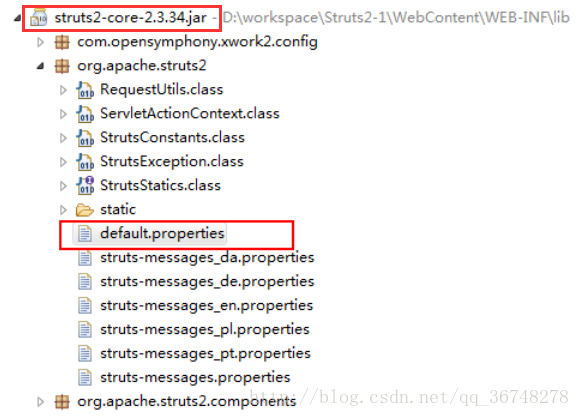
方式三:通配符方法调用
也就是说name属性中的占位符*可以用来指定你想指定的值。第一个通配符匹配的就是属性值为{1}的,第二个通配符就是指定属性值为{2}的值。
看下面表单定义:在action后面加上“_”+函数名
表单login4.jsp
1 <%@ page language="java" contentType="text/html; charset=UTF-8" 2 pageEncoding="UTF-8"%> 3 <!DOCTYPE html PUBLIC "-//W3C//DTD HTML 4.01 Transitional//EN" "http://www.w3.org/TR/html4/loose.dtd"> 4 <html> 5 <head> 6 <meta http-equiv="Content-Type" content="text/html; charset=UTF-8"> 7 <title>登录实例</title> 8 </head> 9 <body> 10 <form action = "Login4_test04" method="post"> 11 <p>用户名1 <input type = "text" name="users[0].username"/></p> 12 <p>密码 <input type = "text" name="users[0].password"/></p> 13 <p>用户名2 <input type = "text" name="users[1].username"/></p> 14 <p>密码 <input type = "text" name="users[1].password"/></p> 15 <input type = "submit" value = "登录"/> 16 </form> 17 </body> 18 </html>
然后在struts.xml中进行匹配:
1 <action name="Login4_*" class="action.MyParaAction2" method="{1}"> 2 <result name="success">/index.jsp</result> 3 </action>
运行效果同上。
OGNL封装MAP
给出例子如下:
1 package action; 2 3 import java.util.List; 4 import java.util.Map; 5 6 import com.opensymphony.xwork2.ActionSupport; 7 8 import login.User; 9 10 public class MyParaAction2 extends ActionSupport { 11 12 //创建用户对象,在JSP中用OGNL封装对象来获取参数 13 private User user; 14 //创建List对象,在JSP中用OGNL封装列表list来获取参数 15 private List<User> users; 16 //创建Map对象,在JSP中用OGNL封装Map来获取参数 17 private Map<String, User> userMap; 18 19 /** 20 * @return the user 21 */ 22 public User getUser() { 23 return user; 24 } 25 26 /** 27 * @param user the user to set 28 */ 29 public void setUser(User user) { 30 this.user = user; 31 } 32 33 /** 34 * @return the users 35 */ 36 public List<User> getUsers() { 37 return users; 38 } 39 40 /** 41 * @param users the users to set 42 */ 43 public void setUsers(List<User> users) { 44 this.users = users; 45 } 46 47 48 49 /** 50 * @return the userMap 51 */ 52 public Map<String, User> getUserMap() { 53 return userMap; 54 } 55 56 /** 57 * @param userMap the userMap to set 58 */ 59 public void setUserMap(Map<String, User> userMap) { 60 this.userMap = userMap; 61 } 62 63 public String test01(){ 64 65 System.out.println("user info:"+ user.getUsername() +" " + user.getPassword()); 66 return "success"; 67 } 68 69 public String test03(){ 70 System.out.println("test03"); 71 System.out.println("user1 info:"+ users.get(0).getUsername() +" " + users.get(0).getPassword()); 72 System.out.println("user2 info:"+ users.get(1).getUsername() +" " + users.get(1).getPassword()); 73 return "success"; 74 } 75 76 public String test04(){ 77 System.out.println("test04"); 78 System.out.println("user1 info:"+ users.get(0).getUsername() +" " + users.get(0).getPassword()); 79 System.out.println("user2 info:"+ users.get(1).getUsername() +" " + users.get(1).getPassword()); 80 return "success"; 81 } 82 83 public String test05(){ 84 System.out.println("test05"); 85 System.out.println("user1 info:"+ userMap.get("china").getUsername() +" " + userMap.get("china").getPassword()); 86 System.out.println("user2 info:"+ userMap.get("Japan").getUsername() +" " + userMap.get("Japan").getPassword()); 87 return "success"; 88 } 89 }
看表单login5.jsp
1 <%@ page language="java" contentType="text/html; charset=UTF-8" 2 pageEncoding="UTF-8"%> 3 <!DOCTYPE html PUBLIC "-//W3C//DTD HTML 4.01 Transitional//EN" "http://www.w3.org/TR/html4/loose.dtd"> 4 <html> 5 <head> 6 <meta http-equiv="Content-Type" content="text/html; charset=UTF-8"> 7 <title>登录实例</title> 8 </head> 9 <body> 10 <form action = "Login5_test05" method="post"> 11 <p>用户名1 <input type = "text" name="userMap['china'].username"/></p> 12 <p>密码 <input type = "text" name="userMap['china'].password"/></p> 13 <p>用户名2 <input type = "text" name="userMap['Japan'].username"/></p> 14 <p>密码 <input type = "text" name="userMap['Japan'].password"/></p> 15 <input type = "submit" value = "登录"/> 16 </form> 17 </body> 18 </html>
userMap['china'].username来匹配动作类中的map
map集合和上面的list集合类似,只不过在编写ognl表达式有些不同,userMap['china'].username、userMap['china'].password,userMap['china']代表的是map中key为China的value,也就找到了key为China的User对象,然后在进行封装数据即可。看struts.xml配置:同样采用模式匹配来进行动态函数调用。
1 <action name="Login5_*" class="action.MyParaAction2" method="{1}"> 2 <result name="success">/index.jsp</result> 3 </action>
在浏览器输入:http://localhost:8080/Struts2Demo/login5.jsp
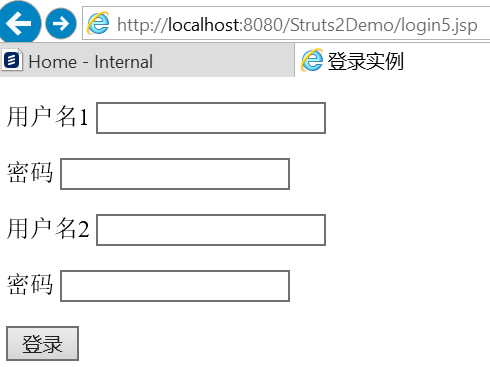
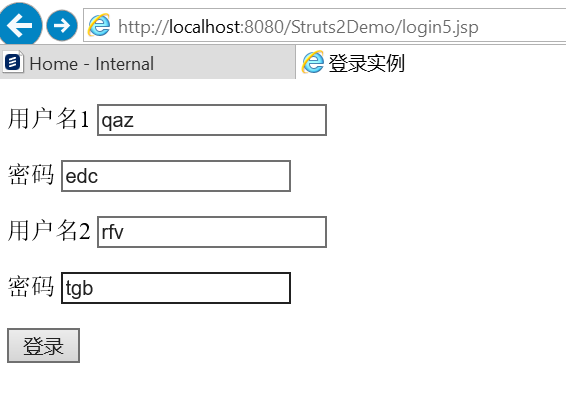
在控制台输出:test05
user1 info:qaz edc
user2 info:rfv tgb。
到此属性驱动的参数封装结束。下面看模型驱动的参数封装:
1.2.1 模型驱动
使用模型驱动进行参数封装时,数据模型必须和动作类方法不在同一个类中。
使用步骤如下:
1. 动作类实现ModelDriven的接口
2. 实现接口中的抽象方法getModel
3. 使用模型驱动时,数据模型必须由我们自己实例化。即
private User user = new User();
此时在form表单中可以直接使用username进行参数传递了~
先看下动作类:MyParaAction3.java
1 package action; 2 3 import com.opensymphony.xwork2.ActionSupport; 4 import com.opensymphony.xwork2.ModelDriven; 5 6 import login.User; 7 8 public class MyParaAction3 extends ActionSupport implements ModelDriven<User> {//动作类实现ModelDriven的接口 9 //使用模型驱动时,数据模型必须由我们自己实例化 10 private User user = new User(); 11 //实现接口中的抽象方法getModel 12 @Override 13 public User getModel() { 14 15 return user; 16 } 17 18 public String test01(){ 19 System.out.println("user info:" + user.getUsername() +" , " + user.getPassword()); 20 21 return "success"; 22 } 23 24 }
看表单数据login6.jsp:
1 <%@ page language="java" contentType="text/html; charset=UTF-8" 2 pageEncoding="UTF-8"%> 3 <!DOCTYPE html PUBLIC "-//W3C//DTD HTML 4.01 Transitional//EN" "http://www.w3.org/TR/html4/loose.dtd"> 4 <html> 5 <head> 6 <meta http-equiv="Content-Type" content="text/html; charset=UTF-8"> 7 <title>登录实例</title> 8 </head> 9 <body> 10 <form action = "Login6_test01" method="post"> 11 <p>用户名1 <input type = "text" name="username"/></p> 12 <p>密码 <input type = "text" name="password"/></p> 13 <input type = "submit" value = "登录"/> 14 </form> 15 </body> 16 </html>
上面是动态参数传递。下面看struts.xml配置:
1 <action name="Login6_*" class="action.MyParaAction3" method="{1}"> 2 <result name="success">/index.jsp</result> 3 </action>
在浏览器输入:http://localhost:8080/Struts2Demo/login6.jsp
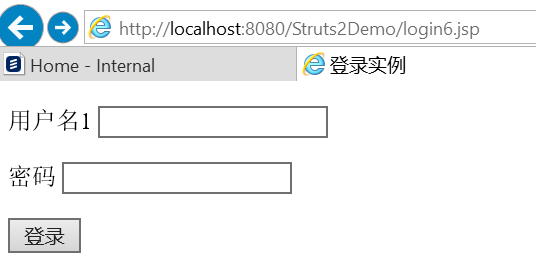
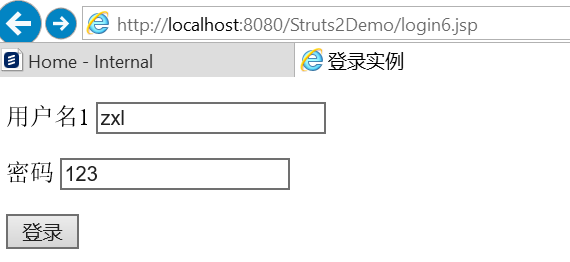
控制台输出:user info:zxl , 123。
这个地方有个主意:如果在jsp中不直接写username, 而是写user.username, 发现action 得不到参数。参数传递失败。
模型驱动方式通过JavaBean模型进行数据传递。只要是普通的JavaBean,就可以充当模型部分。采用这种方式,JavaBean所封装的属性与表单的属性一一对应,JavaBean将成为数据传递的载体。
记住:通过模型驱动时,在表单页面中必须直接按照JavaBean中数据模型来填写参数!
二:struts2参数自动类型转换
上面我们知道了struts2的方便之处,不用我们自己手动来获取请求参数了,struts2中的某些拦截器已经帮我们全部解决好了,我们只需要写get、set方法即可,真是非常方便。不知道大家发现了没有,从表单元素提交过来的都是String类型的,而我们在servlet中获取到表单元素后,得到的是Object类型,也就是需要我们自己手动转型。但是在struts2中,我们却不需要,是因为有这么一个机制,参数类型自动转型,获取过来的参数都是String类型的,但是如果我们需要int型,double型等,都会帮我们自己转换。
下面我们看一个例子:首先给出动作类:定义了不同的数据类型
1 package action; 2 3 import java.util.Date; 4 5 6 import com.opensymphony.xwork2.ActionSupport; 7 8 public class MyParaAction4 extends ActionSupport { 9 private int age; 10 private String name; 11 private float money; 12 private boolean married; 13 private char sex; 14 private Date date; 15 16 17 /** 18 * @return the date 19 */ 20 public Date getDate() { 21 return date; 22 } 23 24 /** 25 * @param date the date to set 26 */ 27 public void setDate(Date date) { 28 this.date = date; 29 } 30 31 /** 32 * @return the age 33 */ 34 public int getAge() { 35 return age; 36 } 37 38 /** 39 * @param age the age to set 40 */ 41 public void setAge(int age) { 42 this.age = age; 43 } 44 45 /** 46 * @return the name 47 */ 48 public String getName() { 49 return name; 50 } 51 52 /** 53 * @param name the name to set 54 */ 55 public void setName(String name) { 56 this.name = name; 57 } 58 59 /** 60 * @return the money 61 */ 62 public float getMoney() { 63 return money; 64 } 65 66 /** 67 * @param money the money to set 68 */ 69 public void setMoney(float money) { 70 this.money = money; 71 } 72 73 /** 74 * @return the married 75 */ 76 public boolean isMarried() { 77 return married; 78 } 79 80 /** 81 * @param married the married to set 82 */ 83 public void setMarried(boolean married) { 84 this.married = married; 85 } 86 87 /** 88 * @return the sex 89 */ 90 public char getSex() { 91 return sex; 92 } 93 94 /** 95 * @param sex the sex to set 96 */ 97 public void setSex(char sex) { 98 this.sex = sex; 99 } 100 101 102 public String test01(){ 103 104 System.out.println("user info:" + name +","+ age +","+ money +","+ sex +","+ married +","+ date); 105 106 return "success"; 107 } 108 109 }
下面给出表单页面login7.jsp
1 <%@ page language="java" contentType="text/html; charset=UTF-8" 2 pageEncoding="UTF-8"%> 3 <!DOCTYPE html PUBLIC "-//W3C//DTD HTML 4.01 Transitional//EN" "http://www.w3.org/TR/html4/loose.dtd"> 4 <html> 5 <head> 6 <meta http-equiv="Content-Type" content="text/html; charset=UTF-8"> 7 <title>登录实例</title> 8 </head> 9 <body> 10 <form action = "Login7_test01" method="post"> 11 <p>int <input type = "text" name="age"/></p> 12 <p>String <input type = "text" name="name"/></p> 13 <p>float <input type = "text" name="money"/></p> 14 <p>boolean <input type = "radio" name="married" value=true checked="checked"/>是 15 <input type = "radio" name="married" value=false />否</p> 16 <p>char <input type = "radio" name="sex" value="男" checked="checked"/>男 17 <input type = "radio" name="sex" value="女" />女</p> 18 <p>日期 <input type = "text" name="date"/></p> 19 20 <input type = "submit" value = "登录"/> 21 </form> 22 </body> 23 </html>
struts配置就不贴出来。在浏览器输入:http://localhost:8080/Struts2Demo/login7.jsp
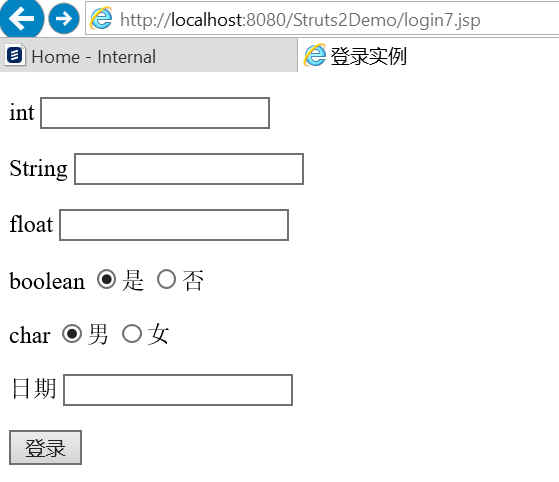
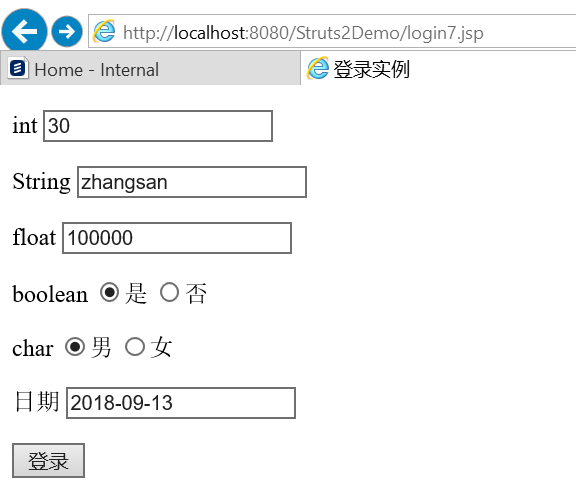
点击登陆,
在浏览器页面输出:Hi, Struts2!!!
在控制台输出:user info:zhangsan,30,100000.0,男,true,Thu Sep 13 00:00:00 CST 2018.
这个地方注意了:上面输入日期的格式必须是:2018-09-13。也就是说,必须是:年-月-日。如果我们按照下面格式输入:
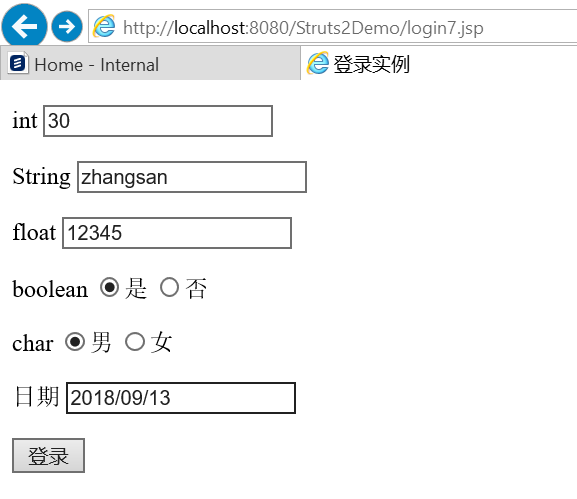
点击登录:会报错。
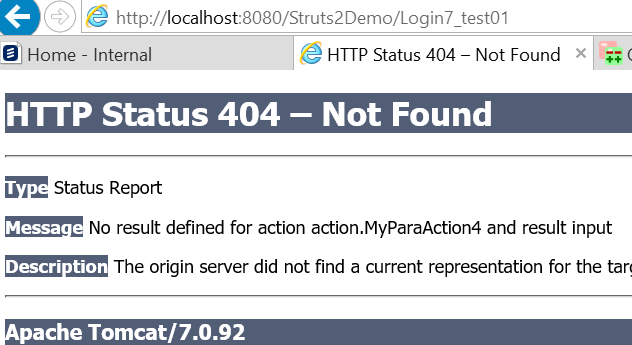
看上面例子,全部都自动转型了,这里需要注意一点,在使用struts2中的日期自动转型时,表单中的日期字符串的格式是固定的,也就是说按照上面那样编程,日期格式必须是那样,没法进行自动转换。但是如果给客户使用,客户就是没按照那种格式来书写,怎么办?
struts2能够让我们自定义类型转换器,格式让我们自己来决定。自定义日期转换器:
只需要两步即可完成:1、继承DefaultTypeConverter类,重写convertValue方法
2、注册转换器。也就是该转换器的作用范围。局部配置和全局配置。
下面给出例子:动作类还是上面那个,只是输入日期可以有好多个格式:
自定义转换器:MyConvert.java
1 package util; 2 3 import java.text.DateFormat; 4 import java.text.ParseException; 5 import java.text.SimpleDateFormat; 6 import java.util.Date; 7 8 import com.opensymphony.xwork2.conversion.TypeConversionException; 9 import com.opensymphony.xwork2.conversion.impl.DefaultTypeConverter; 10 11 public class MyConvert extends DefaultTypeConverter { 12 //支持转换的多种日期格式,可增加时间格式 13 private final DateFormat[] dfs={ 14 new SimpleDateFormat("yyyy年MM月dd日"), 15 new SimpleDateFormat("yyyy-MM-dd"), 16 new SimpleDateFormat("MM/dd/yy"), 17 new SimpleDateFormat("yyyy.MM.dd"), 18 new SimpleDateFormat("yy.MM.dd"), 19 new SimpleDateFormat("yyyy/MM/dd") 20 }; 21 22 /* (non-Javadoc) 23 * @see com.opensymphony.xwork2.conversion.impl.DefaultTypeConverter#convertValue(java.lang.Object, java.lang.Class) 24 */ 25 @Override 26 public Object convertValue(Object value, Class toType) { 27 //用特定格式转换,也就是说输入格式必须是2018/09/13,也即是说字符串的格式只能是这个才可以转换 28 SimpleDateFormat sf = new SimpleDateFormat("yyyy-mm-dd"); 29 30 if(toType == java.util.Date.class){ 31 //获得数据 32 String[] param = (String[])value;//获取日期的字符串 33 34 for(int i=0; i < dfs.length ; i++){//遍历日期支持格式,进行转换 35 36 try { 37 return dfs[i].parse(param[0]);//转化为特定格式的date类型 38 } catch (ParseException e) { 39 continue; 40 } 41 } 42 //如果遍历完毕后仍没有转换成功,表示出现转换异常 43 throw new TypeConversionException(); 44 } 45 //将日期转换为指定的字符串格式 46 if(toType == String.class){ 47 java.util.Date date = (Date) value; 48 return sf.format(date); //输出格式是yyyy-MM-dd 49 } 50 51 return null; 52 } 53 }
然后注册转换器:分两种情况:一种是局部注册,一种是全局注册
局部注册:
位置:action类同包
名称:actionClass-conversion.properties
actionClass:action类的类名
conversion.properties:固定名
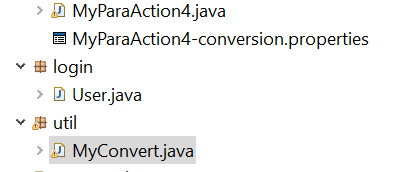
内容:属性=转换器类的全限定类名
date=util.MyConvert
这样一来,我们自定义的转换器就只能在Demo01Action中属性名为date身上使用了,超过了该范围,就会使用struts2默认的转换器。
全局注册:
注册,全局配置
位置:src
名称:xwork-conversion.properties

内容:需要转换得类=转换器
全局配置后,所有在struts2中使用Date型的都会用我们写的转换器进行转换。
本测试中用的是局部注册,然后我们在访问浏览器:http://localhost:8080/Struts2Demo/login7.jsp
在日期那一行就可以输入各种自定义的日期格式了。
到此关于struts的参数封装和自动转换学习完了。有个疑问就是struts在动作类中的参数又是怎么回显到表单的呢?这个是在哪个模块呢?struts标签????
主要参考的帖子有:在此感谢!!!
https://www.cnblogs.com/jingpeipei/p/5945724.html-----日期转换
https://www.cnblogs.com/whgk/category/964133.html------各个功能介绍
https://blog.csdn.net/wjw0130/article/category/2503465-----各个功能介绍
https://blog.csdn.net/q547550831/article/category/6532892-----各个功能介绍
https://blog.csdn.net/xtayfjpk/article/details/14133589-----专门介绍拦截器